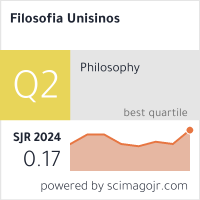Seeing-as and hinge epistemology
DOI:
https://doi.org/10.4013/fsu.2021.221.04Abstract
This paper aims to stablishes the sense in which propositions included under the perceptual use of ‘seeing-as’, developed by Wittgenstein in the Second Part of Philosophical Investigations, are justifiable from an epistemic point of view. To do this, first, it will be clarified the internal link between ‘visual experience’ and ‘interpretation’ for the type of mentioned cases. Second, it will be shown how the ‘seeing-as’ respects the rule-following paradox’s solution, as long as it does not presuppose any intermediary or need anyone to account for what is perceived, highlighting the notions of ‘practice’, ‘familiarity’ and ‘context’ common both in the aforementioned solution and in the ‘seeing-as’ cases. Third, the general distinction between certainties or ‘hinges’ and ‘epistemic propositions’ presented by Wittgenstein in On Certainty will be applied to cases of aspect perception as a possible field of application of the so called Hinge Epistemology, showing how, in specific cases, the perceptual certainties that shape our way of life and that are groundless, can be recontextualized and merit reasonable justification.
Keywords: Wittgenstein, aspect perception, seeing-as, hinges, certainty, justification.
Downloads
Metrics
Downloads
Published
How to Cite
Issue
Section
License
I grant the Filosofia Unisinos – Unisinos Journal of Philosophy the first publication of my article, licensed under Creative Commons Attribution license 4.0 (which allows sharing of work, recognition of authorship and initial publication in this journal).
I confirm that my article is not being submitted to another publication and has not been published in its entirely on another journal. I take full responsibility for its originality and I will also claim responsibility for charges from claims by third parties concerning the authorship of the article.











